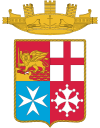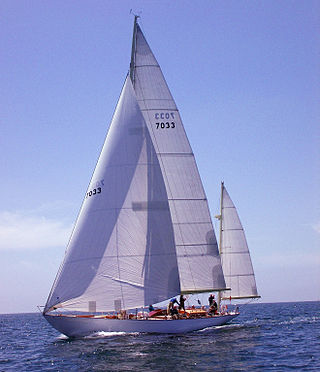
A yawl is a type of boat. The term has several meanings. It can apply to the rig, to the hull type or to the use which the vessel is put.

USS Dace (SS-247), a Gato-class submarine, was the first submarine of the United States Navy to be named for any of several small North American fresh-water fishes of the carp family.

The Amerigo Vespucci is a tall ship of the Italian Navy named after the explorer Amerigo Vespucci. Its home port is La Spezia, Italy, and it is in use as a training ship.

The Italian Navy is the navy of the Italian Republic. It is one of the four branches of Italian Armed Forces and was formed in 1946 from what remained of the Regia Marina after World War II. As of August 2014, the Italian Navy had a strength of 30,923 active personnel, with approximately 184 vessels in service, including minor auxiliary vessels. It is considered a multiregional and a blue-water navy.

USS Nicholson (DD-442), a Gleaves-class destroyer, was the third ship of the United States Navy to be named for the Nicholson family, which was prominent in the early history of the Navy. The destroyer saw service during World War II in the Atlantic, Mediterranean and Pacific theaters. Following the war, the ship was placed in reserve and used as a training ship. In 1951, the destroyer was transferred to Italy and renamed Aviere. In service with the Marina Militare until 1975, Aviere was sunk as a target ship in 1975.

Luigi Cadorna was an Italian Condottieri-class light cruiser, which served in the Regia Marina during World War II; named after Italian Field Marshal Luigi Cadorna who was commander in Chief of the Italian Army during World War I.
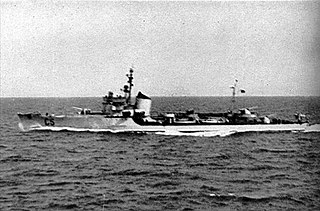
The Spica class were a class of torpedo boats of the Regia Marina during World War II. These ships were built as a result of a clause in the Washington Naval Treaty, which stated that ships with a tonnage of less than 600 could be built in unlimited numbers. Thirty-two ships were built between 1934 and 1937, thirty of which entered service with Italy and two of which were sold to the Swedish Navy in 1940. The two units in Swedish service were classified as destroyers until 1953, then re-classified as corvettes. Although commonly referred to as torpedo boats due to their smaller displacement, the Spica class armaments were similar in design to destroyers and were intended for anti-submarine duties, although they often had to fight aircraft and surface forces as well. Twenty-three vessels were lost during World War II.
Olin James Stephens II was an American yacht designer. Stephens was born in New York City, but spent his summers with his brother Rod, learning to sail on the New England coast. He also attended the Massachusetts Institute of Technology for a term.

The Italian auxiliary cruiser Ramb II was a pre-war banana boat built at Monfalcone by the CRDA in 1937. She briefly served as an auxiliary cruiser with Regia Marina early in World War II before becoming an auxiliary transport with the Imperial Japanese Navy later in her career.
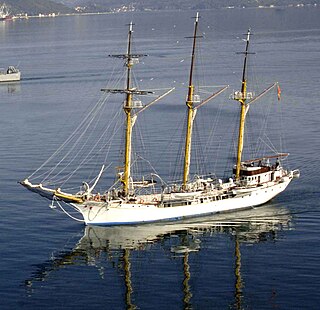
Jadran is a sailing ship for basic naval training built for the Yugoslav Royal Navy and currently in Montenegrin Navy service. A three-mast topsail schooner or barquentine with an auxiliary engine, Jadran was built in Hamburg, Germany between 1930 and 1933, and commissioned on 19 August 1933. Prior to World War II she completed seven long training cruises with trainees from the Yugoslav Naval Academy, including one to North America. As Yugoslavia was neutral at the outbreak of World War II, Jadran was able to conduct short cruises in the Adriatic Sea. In April 1941, Yugoslavia was invaded by the Axis powers, and Jadran was captured and renamed Marco Polo by the Italian Navy. She continued to be used as a training ship in the Adriatic, operating out of the Istrian port of Pola, and was featured in an Italian propaganda film.
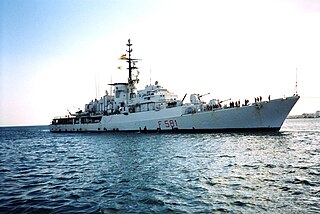
The Alpino class were a group of two frigates built for the Italian Navy during the Cold War.
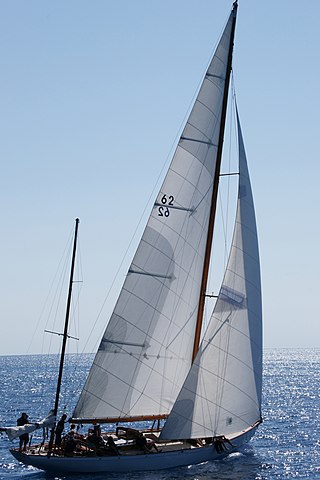
Manitou is a 62-foot-long (18.9 m) performance cruising yacht designed and built for racing on the Great Lakes and specifically to win the Chicago-Mackinac Race. It notably served as a presidential yacht for United States president John F. Kennedy and was known as the "Floating White House." Manitou was built in 1937 at the M. M. Davis & Son shipyard in Solomons Island, Maryland. It was Design No. 99 of naval architects Sparkman & Stephens, who built many America's Cup racing yachts.

Ebe is a former training ship of the Italian Navy. Initially a merchant vessel named San Giorgio, she was acquired by the Navy and used to train non-commissioned officers between 1952 and 1958. Since 1963 she has been preserved and exhibited at the Museo Nazionale Scienza e Tecnologia Leonardo da Vinci in Milan.

Italia is a brigantine, where projects are carried out to fully develop the potential of people with disabilities or social disadvantage. The Ship is led by personnel from the Italian Navy.

Orsa Maggiore is an ocean ketch, serving as a sail training vessel for the Italian Navy. It is an oceanic yacht racing armed as ketch of the Italian Navy's sail section.
Caroly is a yawl, active as a sail training vessel for the Italian Navy.

Stella Polare is a yawl, active as a sails training vessel for the Italian Navy.
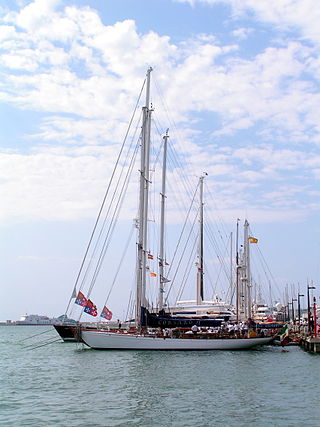
Corsaro II is a yawl, active as a sail training vessel for the Italian Navy

The Cabrini class is a new high-speed multipurpose patrol boat class of the Italian Navy, also known as Unità Navale Polifunzionale ad Alta Velocità (UNPAV) or K-180.
The following is the structure of the Italian Navy as of June 2020. It is considered a multiregional and a blue-water navy.


















